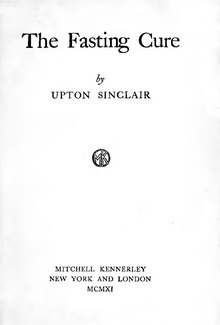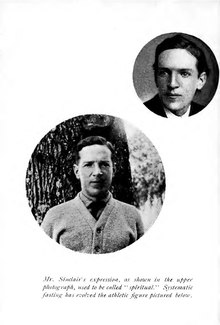The Fasting Cure
 From Wikipedia - Reading time: 7 min
From Wikipedia - Reading time: 7 min
 Title page of The Fasting Cure, first edition, 1911 | |
| Author | Upton Sinclair |
|---|---|
| Language | English |
| Subject | Fasting |
| Publisher | Mitchell Kennerley |
Publication date | 1911 |
| Publication place | United States |
| Media type | |
| Pages | 153 pp |
| OCLC | 14778499 |
| LC Class | RM226 .S5 1911 |

The Fasting Cure is a 1911 nonfiction book on fasting by Upton Sinclair. It is a reprinting of two articles written by Sinclair which were originally published in the Cosmopolitan magazine. It also includes comments and notes to the articles, as well as extracts of articles Sinclair published in the Physical Culture magazine. The book is dedicated to Bernarr Macfadden.
Sinclair was keenly interested in health and nutrition. He experimented with various diets, and with fasting. He writes extensively about fasting in The Fasting Cure, which became a bestseller.[1] Sinclair believed that periodic fasting was important for health, saying, "I had taken several fasts of ten or twelve days' duration, with the result of a complete making over of my health".[2] Sinclair favored a raw food diet of predominantly vegetables and nuts. For long periods of time, he was a complete vegetarian, but he also experimented with eating meat. His attitude to these matters is fully explained in the book's final chapter, "The Use of Meat".[3][4]
The book makes sensational claims of fasting curing practically all diseases, including cancer, tuberculosis, asthma, syphilis, and the common cold.[5][6]
Contemporary reception
[edit]The book was condemned in The Monthly Cyclopaedia and Medical Bulletin by gastroenterologist Anthony Bassler, who described treating many sickly patients who had followed the advice published in Sinclair's The Contemporary Review and Cosmopolitan Magazine articles. The accompanying article in Current Literature criticized Sinclair as a "faddist pure and simple, one whose mind is obsessed by a series of notions one after another, none resting upon any basis that can be called scientific or even sensible."[7]
Legacy
[edit]In his book Terrors of the Table: The Curious History of Nutrition (2005), British biophysicist Walter Gratzer describes Sinclair as "the most credulous of faddists." Gratzer also writes, "In what passes for a caveat he remarks [in his book The Book of Life (1921)]: 'I have known two or three cases of people dying while they were fasting, but I feel quite certain that the fast did not cause their death.' The irony in all this farrago is that we now have good evidence for an increased life-span in rodents kept in laboratory conditions on a very low-calorie diet."[5] Likewise, in the book Quackery: A Brief History of the Worst Ways to Cure Everything (2017), authors Lydia Kang and Nate Pedersen write, "Although modern doctors would strongly disagree with Sinclair's unsolicited medical advice, there have been some recent promising studies on the impact of fasting on mice with cancer. Human studies, however, are still lacking."[8]
In popular culture
[edit]Sinclair appears in T. C. Boyle's novel The Road to Wellville (1993), which is built around a historical fictionalization of John Harvey Kellogg, the inventor of Corn Flakes and the founder of the Battle Creek Sanitarium. In the book, Sinclair and his first wife, Meta, appear as patients at the Sanitarium. Later, Kellogg is outraged when he discovers that another of his patients has been fasting after reading a typescript of Sinclair's The Fasting Cure.[9]
See also
[edit]References
[edit]- ^ "'The Fasting Cure', by Upton Sinclair", Soil and Health
- ^ "Perfect Health!" (chapter), The Fasting Cure, at Soil and Health
- ^ "The Use of Meat" (chapter). The Fasting Cure, at Soil and Health
- ^ Sinclair, Upton (1911). "The Use of Meat". The Fasting Cure. Digitized by Harvard University. New York: Mitchell Kennerly. pp. 86–104. ISBN 9781852286095.
- ^ a b Gratzer, Walter (2005). Terrors of the Table: The Curious History of Nutrition. Oxford University Press. p. 201. ISBN 0-19-280661-0.
- ^ Nash, Jay R. (1982). Zanies: The World's Greatest Eccentrics. New Century Publishers. p. 339. ISBN 978-0832901232.
- ^ ""The Fasting Cure" Found Wanting By A Gastronomic Authority". Current Literature. Vol. 51. 1911. pp. 163–165.
- ^ Kang, Lydia; Pedersen, Nate (2017). Quackery: A Brief History of the Worst Ways to Cure Everything. Workman Publishing. p. 265. ISBN 978-0-7611-8981-7.
- ^ Boyle, T. C. (May 1, 1994). The Road to Wellville. Penguin. ISBN 978-1-101-64026-5.
Further reading
[edit]- Dewey, Edward H. (1900). The No-Breakfast Plan and the Fasting-Cure. Meadville, Pennsylvania: Self-published.
- Carrington, Hereward (1908). Vitality, Fasting, and Nutrition: A Physiological Study of the Curative Power of Fasting, Together With a New Theory of the Relation of Food to Human Vitality. New York: Rebman.
- Hazzard, Linda Burfield (1908). Fasting for the Cure of Disease. Seattle: Harrison Publishing Co.
- Sinclair, Upton (1921). The Book of Life: Mind and Body. Pasadena, California: Self-published.
- Buchinger, Otto (1935). Das Heilfasten und seine Hilfsmethoden (in German). Stuttgart-Leipzig: Hippokrates-Verlag.
 KSF
KSF